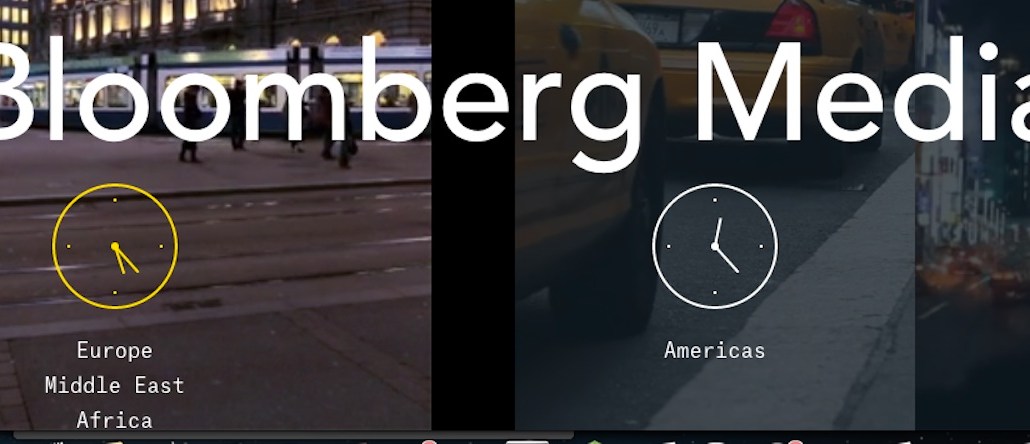Save 50% on a 3-month Digiday+ membership. Ends Dec 5.

The rise of big data holds out big promises for marketers. And if there’s any media company that has information on its customers, it’s Bloomberg LP, which claims to generate 1.3 billion data points a day on visitors to its Web media properties.
But while Bloomberg has used that information on the product side, it hasn’t put it to work for advertisers.
And as Bloomberg’s massive terminal business faces challenges to growth, the company is looking to its media arm, led by Justin Smith, for expansion. He has made big-name hires and is launching new verticals. To attract advertisers to them, he is now taking a new look at data.
Spearheading the effort is Bloomberg Media’s head of global media marketing, Zazie Lucke. Lucke said she saw a big opportunity to help CMOs who have no shortage of data but need help figuring out what to do with it.
“There were tons of data that weren’t being used to its fullest extent,” she said. “The editorial side was looking at it, but the business side wasn’t using the data to sell.”
Lucke put a Bloomberg data scientist, Hannah Diddams, in charge of a 10-person group. (And to show how seriously Bloomberg is taking this effort, Diddams named as her chief data scientist Pat Moore, whose previous job was identifying people who were trying to hack into the Bloomberg terminal).
Together, they’ve created a suite of data-informed ad products, starting with a native ad offering that rolled out last May. The new, flagship product is BMATCH, which helps advertisers find their target audience and then bakes information about them into their media plan. It doesn’t come cheap: Bloomberg charges six figures for the program.
Ad position: web_incontent_pos1
Bloomberg said it’s working with several clients for BMATCH, and it declined to identify its clients on the record but gave some examples of how the program is working.
In one case, an airline manufacturer wanted information about its customers’ interests. Bloomberg identified its own visitors who also were core customers of the marketer. Then, by tracking their journeys on Bloomberg’s media properties, Bloomberg could see which subjects they tend to read more about (not surprisingly, two of them were energy and the price of oil) and could even to quantify their interest.
Another advertiser, a public company, wanted to know more about its mom-and-pop investors. Bloomberg identified visitors who were coming from their home computers and also visiting Yahoo Finance, which suggested they weren’t institutional investors.
Data also is being put to use as a consultative selling tool. Another new product, Brand View, pulls disparate, hard-to-find financial information about a given company from Bloomberg LP and displays it in an easy-to-read format to aid in the ad sales process. While sophisticated marketers might already have that information at hand, Lucke said, “the agencies find this very, very interesting.”
The intensified use of data brings Bloomberg closer to digital pure-plays, observed Peter Kreisky, chairman of the Kreisky Media Consultancy.
Ad position: web_incontent_pos2
“It’s clear that Mr. Bloomberg, who has returned to the organization, sees the media business as being underleveraged,” he said. “This is a glimpse into how you draw a thread through a lot of aspects of the business he’s trying to integrate. It’s not just selling terminals; it’s using the terminals to drive the media business.”
Just as publishers elsewhere are looking for ways to stretch their existing expertise to new revenue streams, Bloomberg could wring standalone products out of its data. Brand View, for example, could become a separately sold product rather than just a tool to use in the sales process. The company is also starting to have conversations about how to use the data science to help the editorial side.
Bloomberg believes its data-driven approach is on point as media buyers try to replace the click with better measures of performance. Its typical B2B reader may not click to buy a product in response to an ad, but Bloomberg can use its data and metrics like time spent, white paper downloads and pages viewed as a proxy for reaching advertisers’ target audiences. “Our goal,” Lucke said, “is to move beyond the click.”
Homepage image courtesy of Gil C / Shutterstock.com
More in Media

What publishers are wishing for this holiday season: End AI scraping and determine AI-powered audience value
Publishers want a fair, structured, regulated AI environment and they also want to define what the next decade of audience metrics looks like.

Digiday+ Research Subscription Index 2025: Subscription strategies from Bloomberg, The New York Times, Vox and others
Digiday’s third annual Subscription Index examines and measures publishers’ subscription strategies to identify common approaches and key tactics among Bloomberg, The New York Times, Vox and others.

From lawsuits to lobbying: How publishers are fighting AI
We may be closing out 2025, but publishers aren’t retreating from the battle of AI search — some are escalating it, and they expect the fight to stretch deep into 2026.
Ad position: web_bfu